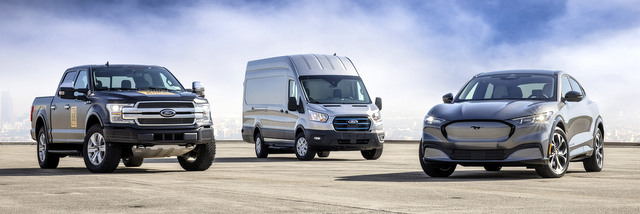Ford previewed the upcoming electric version of its best-selling Transit van, putting down a marker for the company in the exploding commercial EV market. The 2022 Ford E-Transit, due to arrive in late 2021, will start at about $46,000 and offer 126 miles of range in its most efficient version. It rear-wheel drive electric motor will deliver 266 horsepower (198 kilowatts) and 317 lb.-ft. of torque, power comparable to the current gas and diesel versions. Ford president and CEO Jim Farley introduced the van as part of the company’s portfolio of electrified commercial and personal-use vehicles, which will be led by the Mustang Mach-E later this year. As was explained later, the single drivetrain approach is geared to hit the “sweet spot” of the market, short-range work that can be down within the E-Transit’s range—or augmented by its fast-charging capability. Ford North America general manager of commercial business Ted Cannis said the company’s plan was “to play to our strength.” One key element of the electric Transit is that its body dimensions are identical to the current internal combustion engine version so upfitters, who finish off virtually all of the vehicles in this segment, won’t have to make any adjustments. Ford noted that 13 upfitters had facilities located within 30 miles of the assembly plant. The crossover between the E-Transit and other Ford electric offerings is clear, too. Ford will be using the came LG Chem cells for the battery packs for the Mach-E and the E-Transit. The all-electric F-150 due in 2022 will take a similar commercial-vehicle focused approach.
Commercial vehicle specs
The E-Transit will be a Class 2 van with a payload capacity of up to 4,290 pounds and a maximum GVWR of 9,500 pounds. Cargo space in the high-roof, extended wheelbase variant is 487.3 cubic feet. The 67 kilowatt-hour battery pack is below the vehicle’s floor. Ford indicated the size of the battery pack (and hence the range) could be increased in future models. To be built in Ford’s Kansas City Assembly Plant, the E-Transit will be offered in three configurations (cargo, cutaway, and chassis cab) with three roof heights and three body lengths, matching the versions offered by its gas-powered predecessors. A passenger version may come later, Ford added in response to questions. In addition to the battery pack underneath the cargo floor, the E-Transit also has a new rear trailing-arm suspension, designed to accommodate both the batteries and supply better traction, more precise steering, and more confident handling. The E-Transit’s is designed to charge on Level 1 and 2 as well as DC fast chargers. Ford will offer its Connected Charge Stations as part of the vehicle purchase. On a 115-kilowatt fast charger, the E-Transit will be capable of adding approximately 30 miles of range in 10 minutes and 45 miles of range in 15 minutes.
Tech boost
Recognizing that technology is even more critical in an electric commercial vehicle, Ford plans to add a full complement of advanced technology. In the cab, customers will be able to activate data subscriptions over its standard 4G LTE system to maximize fleet efficiency. Ford Commercial Solutions will offer a range of dedicated electric vehicle services. The offerings will integrate existing technology services like vehicle pre-conditioning—which optimizes cabin temperatures—with considerations for vehicle charging to maintain the best battery efficiency. The Ford E-Transit will offer Sync 4 communications and entertainment technology, featured on the new standard 12-inch touch screen, along with enhanced voice recognition and cloud-enhanced navigation. Ford plans to offer over-the-air updates for software to keep the vehicle up-to-date. Ford will also include its Co-Pilot360 technology, which includes adaptive cruise control, which can identify speed limits and automatically adjust vehicle speed accordingly. Other technologies in the Co-Pilot360 package include lane-keeping, pre-collision assist, automatic emergency braking, blind spot assist, a 360-degree camera , and reverse brake assist.
Joining the CV rush
The $46,000 starting price for the E-Transit is about $6,000 more than the base gas model, though Ford expects incentives to narrow the price gap while lower operating costs should pay back the higher cost relatively quickly. An electric van can also offer features not available on ICE models, such as the Pro Power Onboard, which turns the E-Transit into a mobile generator capable of providing 2.4 kilowatts of power to use to run job site tools or for other projects. Ford currently owns almost half of the American commercial vehicle market, backed with 645 commercial vehicle centers in the U.S., and is using the E-Transit (and the coming electric F-150) as its main bets to keep that leadership position. You can follow Clean Fleet Report on Twitter and Facebook.
SHIFT is brought to you by Polestar. It’s time to accelerate the shift to sustainable mobility. That is why Polestar combines electric driving with cutting-edge design and thrilling performance. Find out how.





